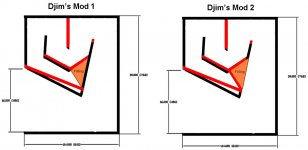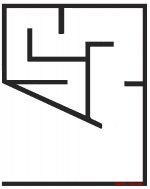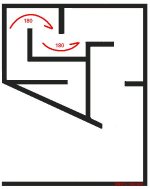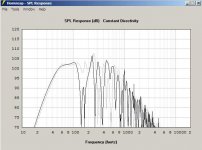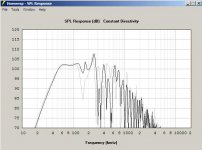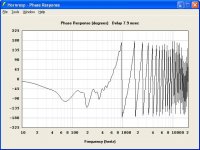JBell, concentrate on the 47-60 area (and your 40Hz rises with it). It will cost 1 or 2dB at 90Hz, but at full load you can gain 2 or 3dB around 50Hz. Two cabs together should make up the loss at 90Hz.
At hifi power your SS15 gives more low end. At PA power levels an 'mod' gives more SPL at <70Hz. In short range the SS15 gives best response, in >10m distances an 'mod' version should have a better response. The more cabs, the more the 'mod' will benefit.
At hifi power your SS15 gives more low end. At PA power levels an 'mod' gives more SPL at <70Hz. In short range the SS15 gives best response, in >10m distances an 'mod' version should have a better response. The more cabs, the more the 'mod' will benefit.
Hi Y'all,
Just fiddling with the parameters one at a time in the Wizard:
S1 - doubled = dip @ ~~160-210Hz gets larger; cut in half gets smaller; set to 1 looks best
L12 - doubled = ragged top end; halfed same area as in S1 improves; set to .1 dip @ 90Hz increases slightly
S2 - doubled = increase @ the very low end; dip @ ~~150-220 gets much larger, losses from 50-80Hz; cut in half: losses @ low end, peaking @70-80Hz, dip @~~150-220Hz gone, but peak in that area bigger
S3 - doubled = peak @ 50Hz, more output @40Hz, dip @160Hz increases, dip @210Hz decreases; cut in half: changes reverse
L23 - +50cm = better low end, lower SPL in the passband, dip @ 140Hz increases, dip @180Hz decreases (everything shifted down in frequency; -50cm = everything shifted upwards, looses more low end, dip now from ~~190Hz-280Hz
S4 - increasing area increases output in passband, but does not add to low end, improves first upper dip; decreasing area decreases output in passband, but does not affect area below 50Hz, big dip @170Hz
L34 - similar to L23
S5 - similar to S4, stays pretty even over a wide range for the SS15, e.g.: ~~1700-2500cm^2
L45 - "rotates" the dips around the first peak at ~~170Hz, longer = left dip decreases, right dip increases, shorter = left dip increasses, right dip decreases.
The 1st try at the Djim modification looks almost identical to the original SS15, maybe 1 dB lost @ 50Hz, and 1dB gained @200Hz.
Well, we are just fiddling.
Regards,
Just fiddling with the parameters one at a time in the Wizard:
S1 - doubled = dip @ ~~160-210Hz gets larger; cut in half gets smaller; set to 1 looks best
L12 - doubled = ragged top end; halfed same area as in S1 improves; set to .1 dip @ 90Hz increases slightly
S2 - doubled = increase @ the very low end; dip @ ~~150-220 gets much larger, losses from 50-80Hz; cut in half: losses @ low end, peaking @70-80Hz, dip @~~150-220Hz gone, but peak in that area bigger
S3 - doubled = peak @ 50Hz, more output @40Hz, dip @160Hz increases, dip @210Hz decreases; cut in half: changes reverse
L23 - +50cm = better low end, lower SPL in the passband, dip @ 140Hz increases, dip @180Hz decreases (everything shifted down in frequency; -50cm = everything shifted upwards, looses more low end, dip now from ~~190Hz-280Hz
S4 - increasing area increases output in passband, but does not add to low end, improves first upper dip; decreasing area decreases output in passband, but does not affect area below 50Hz, big dip @170Hz
L34 - similar to L23
S5 - similar to S4, stays pretty even over a wide range for the SS15, e.g.: ~~1700-2500cm^2
L45 - "rotates" the dips around the first peak at ~~170Hz, longer = left dip decreases, right dip increases, shorter = left dip increasses, right dip decreases.
The 1st try at the Djim modification looks almost identical to the original SS15, maybe 1 dB lost @ 50Hz, and 1dB gained @200Hz.
Well, we are just fiddling.
Regards,
Last edited:
These are my first suggestions, but I'm working on a third one with more accuracy. The left one works like this, path length extension but only for low frequencies (cause of the use of filling). You will have to experiment with the amounts of filling (density). You want only <100Hz waves using this extension.
Second one is more an experiment. If it works depends on how air molucules are behaving around the last bend. Because of the sharper bend I hope the speed will increase and waves make use of the longer path. The use of filling is like the same. You don't want >100Hz using the 'cavity' as resonators. No warranty if it will work as planned but I hope it takes away the dip upwards and change enough low freq that can benefit from the sharp corner. It could also work opposite since I have no tools to check 1/2 wave calculations. But the trick here is in the filling (probably quiet dense).
Black lines old situation, red lines mods, orange/brown acoustic filling...
Second one is more an experiment. If it works depends on how air molucules are behaving around the last bend. Because of the sharper bend I hope the speed will increase and waves make use of the longer path. The use of filling is like the same. You don't want >100Hz using the 'cavity' as resonators. No warranty if it will work as planned but I hope it takes away the dip upwards and change enough low freq that can benefit from the sharp corner. It could also work opposite since I have no tools to check 1/2 wave calculations. But the trick here is in the filling (probably quiet dense).
Black lines old situation, red lines mods, orange/brown acoustic filling...
Attachments
And here is the third one. Light grey is old situation, blue is optional. No expansion in those short distances for easy building (wont change the output anyway) Yes sir, all hand drawn  with paint... bunkers!
with paint... bunkers!
 with paint... bunkers!
with paint... bunkers!Attachments
Last edited:
If you wanna have it more radical, this one has no 2x 90 bends facing, last bend is almost 180 degrees and you have a little more control over the last expansion. Only needs one bracing stud for the bottom panel since all other outside panels have bracing. As you can see haven't worked it out and no idea if it fits the one sheet challenge.
Attachments
If this works well...
This would make for a very fast and easy build! Much appreciated by those of us with limited tools / skills.
Regards, Ben
If you wanna have it more radical, this one has no 2x 90 bends facing, last bend is almost 180 degrees and you have a little more control over the last expansion. Only needs one bracing stud for the bottom panel since all other outside panels have bracing. As you can see haven't worked it out and no idea if it fits the one sheet challenge.
This would make for a very fast and easy build! Much appreciated by those of us with limited tools / skills.
Regards, Ben
If you wanna have it more radical, this one has no 2x 90 bends facing, last bend is almost 180 degrees and you have a little more control over the last expansion. Only needs one bracing stud for the bottom panel since all other outside panels have bracing. As you can see haven't worked it out and no idea if it fits the one sheet challenge.
Not sure what you mean by no 2x90 degree bends??
Attachments
Isn't it...
...virtually only 90 degree bends (and multiples thereof)?
Regards, Ben
P.S. JBell - you were right, lying on their sides on the floor with bottoms touching is excellent! Seriously outperformed the first time when they were split and upright, despite being much further from walls than before!
The promoter said he finally understood why the damn things (stadium horns) were so big and heavy!
...virtually only 90 degree bends (and multiples thereof)?
Regards, Ben
P.S. JBell - you were right, lying on their sides on the floor with bottoms touching is excellent! Seriously outperformed the first time when they were split and upright, despite being much further from walls than before!
The promoter said he finally understood why the damn things (stadium horns) were so big and heavy!
Last edited:
Hi Djim,
Post #663: "Oliver, what was wrong with your mod from post # 581 ?"
- Nothing in particular, as I said, I like it (with and without the wiggle in the back horn section) but it is bigger than the SS15, not a single sheet box.
Post #664: "...path length extension..."
- Does not work with this driver, yours kills the region from ~~130-210Hz, does not add much below 45Hz, and looses output from ~~50Hz-80Hz. As you are indicating, with this type of construction you are back to build-test-modify, and guess again. What seems to help consistently with this driver is to reduce the L12 distance, and/or reduce S1, or couple the driver as closely as possible to the throat (S2).
I don't know if soho54 could model something like the ones in #664/665/666 in AkAbak. I did a complete fold similar to #666 to find room for a chamber to house Helmholtz resonators close to the throat, but again, that would belong into a different thread.
Keep on trying, I'll try to fire up AkAbak for the SS15, but I don't have any hope for extending the low end response within the parameters of the project.
Attached is a quick try at your modifications (driver board/throat extension) in Hornresp.
Regards,
Post #663: "Oliver, what was wrong with your mod from post # 581 ?"
- Nothing in particular, as I said, I like it (with and without the wiggle in the back horn section) but it is bigger than the SS15, not a single sheet box.
Post #664: "...path length extension..."
- Does not work with this driver, yours kills the region from ~~130-210Hz, does not add much below 45Hz, and looses output from ~~50Hz-80Hz. As you are indicating, with this type of construction you are back to build-test-modify, and guess again. What seems to help consistently with this driver is to reduce the L12 distance, and/or reduce S1, or couple the driver as closely as possible to the throat (S2).
I don't know if soho54 could model something like the ones in #664/665/666 in AkAbak. I did a complete fold similar to #666 to find room for a chamber to house Helmholtz resonators close to the throat, but again, that would belong into a different thread.
Keep on trying, I'll try to fire up AkAbak for the SS15, but I don't have any hope for extending the low end response within the parameters of the project.
Attached is a quick try at your modifications (driver board/throat extension) in Hornresp.
Regards,
Attachments
P.S. JBell - you were right, lying on their sides on the floor with bottoms touching is excellent! Seriously outperformed the first time when they were plit and upright, despite being much further from walls than before!
The promoter said he finally understood why the damn things (stadium horns) were so big and heavy!
ALLLLRIGHT !!! Glad you had a success. I always enjoy hearing about success.
I believe symmetrical designs are way easier to build. I did the same for the THAM and it worked. We build our cabs under pressure (ton/cm2) and then 90 degrees connections are way easier to setup.This would make for a very fast and easy build! Much appreciated by those of us with limited tools / skills.
When two 90 degrees bends face each other, for instance like in your cube model. That ‘style’ is non-gentle bending. Always try to go for S bends. I’ll show the 180 degree bends (look at their centre point). Corners a,b and c are 90 degrees (although bend c is actually not).Not sure what you mean by no 2x90 degree bends??
Attachments
I like this one but the path length seems to be shorter than the SS15. AndyIf you wanna have it more radical, this one has no 2x 90 bends facing, last bend is almost 180 degrees and you have a little more control over the last expansion. Only needs one bracing stud for the bottom panel since all other outside panels have bracing. As you can see haven't worked it out and no idea if it fits the one sheet challenge.
Oliver, the extra cavity is supposed to be filled with acoustic materials. Dense enough so NO frequencies above 100Hz will see the extension. So for >100Hz it’s the same path only with a squeezed end. And yes that techniques works. This technique is exactly what you use in acoustic treatment for studio’s. The slightly rotated driver panel works and JBell already used it with success, I believe.Post #664: "...path length extension..." (Djim’s Mod1)
- Does not work with this driver, yours kills the region from ~~130-210Hz, does not add much below 45Hz, and looses output from ~~50Hz-80Hz. As you are indicating, with this type of construction you are back to build-test-modify, and guess again. What seems to help consistently with this driver is to reduce the L12 distance, and/or reduce S1, or couple the driver as closely as possible to the throat (S2).
The idea is not to use the cavity as a Helmholtz resonator. Again the filling must be dense enough to let low frequency trough and higher frequencies not. I think you are missing the concept here. I don’t know if Akabak can be predicting such thing.I don't know if soho54 could model something like the ones in #664/665/666 in AkAbak. I did a complete fold similar to #666 to find room for a chamber to house Helmholtz resonators close to the throat, but again, that would belong into a different thread
Like I said before, I never had the intention to extend the low end. Maybe a little extra 47Hz (that runs out to 40Hz) and hopefully not to much at cost of 90hz…Keep on trying, I'll try to fire up AkAbak for the SS15, but I don't have any hope for extending the low end response within the parameters of the project.
Could you share your txt file from your HornResp?Attached is a quick try at your modifications (driver board/throat extension) in Hornresp.
Andy, the length sits in the bends. It’s just a quick schematic drawing, not very accurate. The strengths of this design sits in the constant changing of the airwaves. So there is no long path where ½ wave cancellations or long turbulances can develop. Also the 180 “S” folds make sure that each time the other side of the bend changes the air mass. Another interesting thing is the many corners which can help in finding the right spots for problem areas within the band pass.I like this one but the path length seems to be shorter than the SS15. Andy
Last edited:
Oliver, if you are that worried about the upperband then paint the last piece you put in (with a primer for instance, make sure it doesn't 'eat' the foam). Painted side towards the cone of course...
This will ad a reflective film on the surface.
This will ad a reflective film on the surface.
Hi Djim,
Interesting suggestions. I'm looking for something that produces results in Hornresp or in AkAbak at a basic level. I would have a hard time to simulate a corner packing with, e.g.: latex paint seal cover. Anyway, always interesting, keep 'em coming.
I'm attaching another SPL window, and the .txt files for Hornresp.
Regards,
Interesting suggestions. I'm looking for something that produces results in Hornresp or in AkAbak at a basic level. I would have a hard time to simulate a corner packing with, e.g.: latex paint seal cover. Anyway, always interesting, keep 'em coming.
I'm attaching another SPL window, and the .txt files for Hornresp.
Regards,
Attachments
Reading this tread with most interest indeed. But I have a question, how high can you cross this sub, if you push it? I read earlier a couple 40 pages back that Jbell mentioned something about "sounding good up to 200hz and maybe 250hz". Have anybody played them that high and how does it sound?
I have this tops that highpass at 250hz. It would be such a neat system...
Thanks in advance!
/Anders
I have this tops that highpass at 250hz. It would be such a neat system...

Thanks in advance!
/Anders
Reading this tread with most interest indeed. But I have a question, how high can you cross this sub, if you push it? I read earlier a couple 40 pages back that Jbell mentioned something about "sounding good up to 200hz and maybe 250hz". Have anybody played them that high and how does it sound?
I have this tops that highpass at 250hz. It would be such a neat system...
Thanks in advance!
/Anders
While I've only personally listened to every 1hz sine waves up through 200hz, I've tested up through 250hz with nothing ugly sounding. As long as your tops are above subs, so there isn't any midbass localization from 100-250, I see no reason at all why this wouldn't work for you.
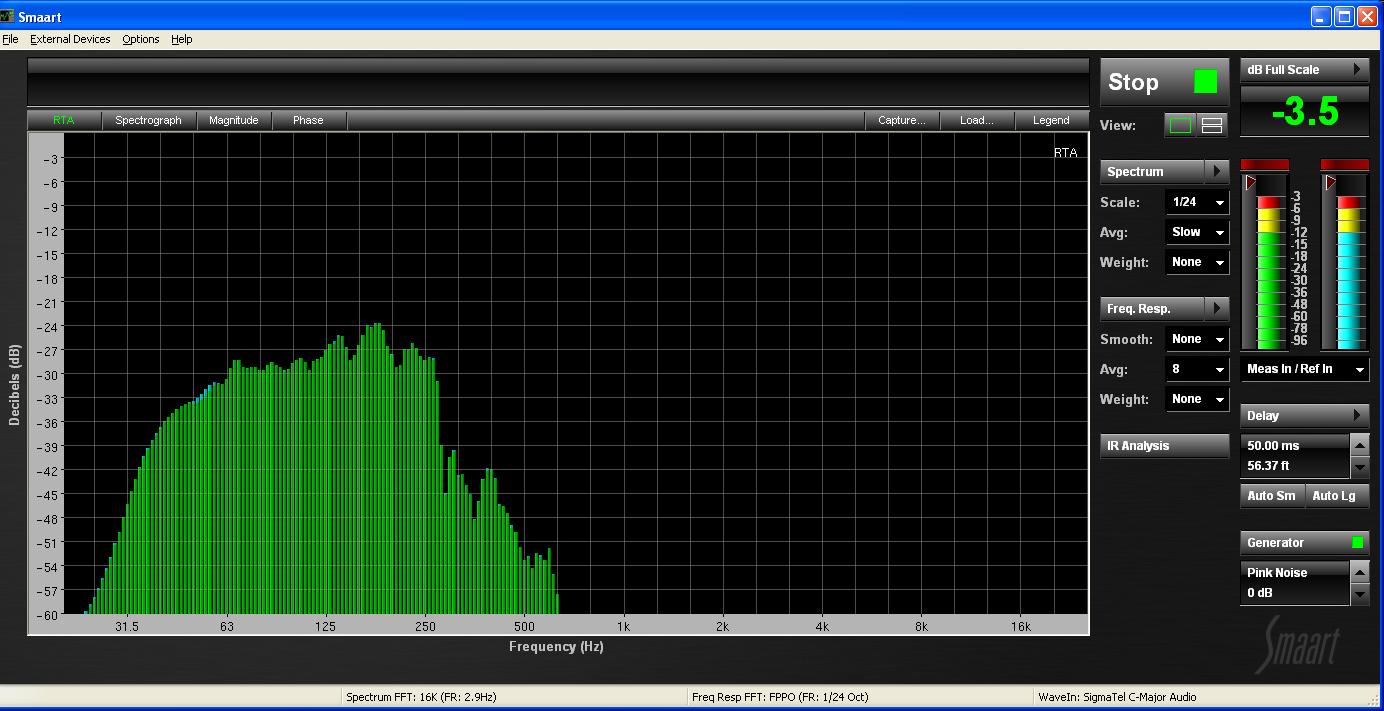
I see two possible problems with crossing a SS15, (or any TH with a FB 50 Hz or lower) at 200 to 250 Hz .While I've only personally listened to every 1hz sine waves up through 200hz, I've tested up through 250hz with nothing ugly sounding. As long as your tops are above subs, so there isn't any midbass localization from 100-250, I see no reason at all why this wouldn't work for you.

The TH may be a lot tighter pattern than the midbass above it at 250 Hz, systems always sound better when dispersion patterns match at the crossover point.
My Keystone TH is about 90 degree dispersion at 125Hz (6dB down point), it probably is only 45 degrees at 250. I'd expect the SS15 may even be more narrow that high, considering the mouth shape differences between the two cabinets.
It would take a huge,very long mid horn to have 45 degree pattern control at 250 Hz.
Problem two may be a difficulty in matching phase at the high crossover point, IIRC the SS15 phase is going through a big phase swing that high. Matching the phase (using delay) at 250 Hz will result in a rapid phase change below the crossover point, which sounds unnatural.
Jim, have you ever posted the phase response of the SS15 ?
Does it match the simulation ?
Art
Last edited:
- Home
- Loudspeakers
- Subwoofers
- Single sheet TH challenge
